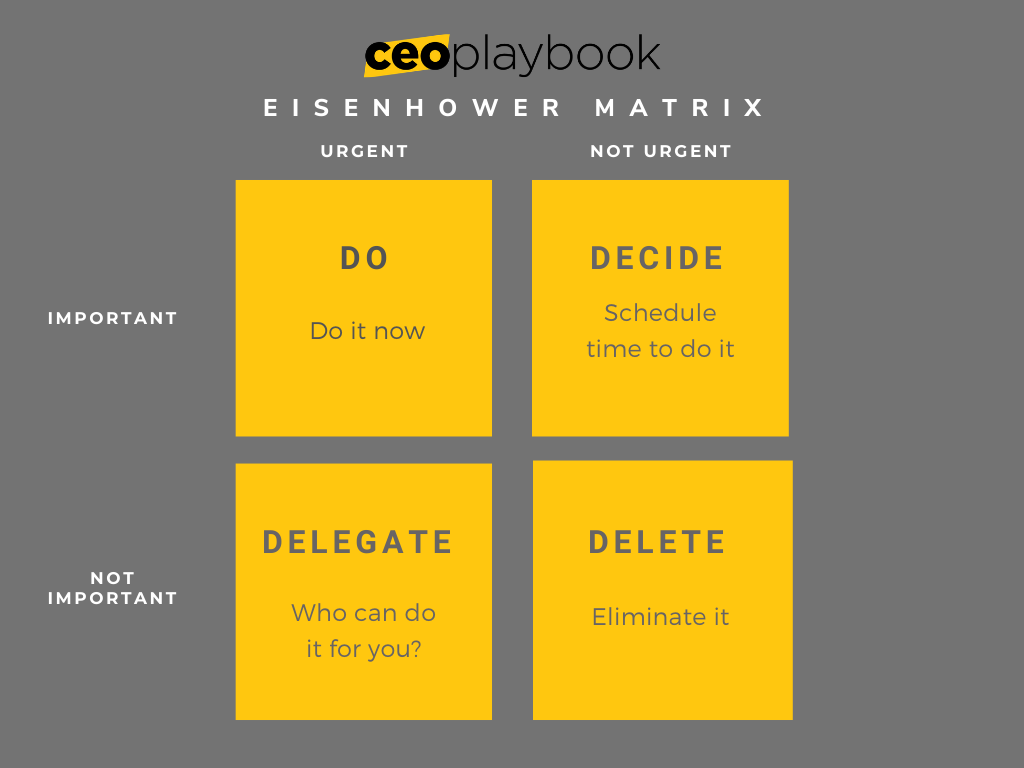If you are like me, you hate meetings.
They can be a colossal waste of time. Many are filled with the wrong people, have no agenda, and don’t seem to end with a clear set of tasks with owners.
In fact, if you added up the amount of time you spent in unproductive meetings, you’d likely recover countless hours of productivity.
So, why have them at all?
In a word, it’s about discipline.
To be a successful CEO, you have to:
(1) build an organization with the right DNA,
(2) get clear and be laser-focused,
(3) build a magnetic culture,
(4) over communicate the organization’s purpose,
(5) create an operating system that creates the discipline required to maintain the organization’s cohesion.
At the heart of a sound operating system is a series of regular meetings. Not just any meeting, but the right meetings.
As Patrick Lencioni from The Table Group puts it:
An organization that has embraced each of the four disciplines [of a healthy organization] will undoubtedly become healthy, making success highly likely. But one activity, more than any other, will be central to maintaining those disciplines and sustaining health over time. No action, activity, or process is more central to a healthy organization than the meeting. As dreaded as the “m” word is, as maligned as it has become, there is no better way to have a fundamental impact on an organization than by changing the way it does meetings.
In fact, if someone were to offer me one single piece of evidence to evaluate the health of an organization, I would not ask to see it’s financial statements, review it’s product lines, or even talk to its employees or customers; I would want to observe the leadership team during a meeting.
I can relate to his point.
I remember a time in one of my companies where my management team meetings were toxic experiences with scarce accountability, elusive trust among the team, and lack of clarity. It was demoralizing for me. Today, I carefully observe my team members’ behavior and temperament during meetings to detect and address issues ahead of time.
So, what are the right types of meetings for a leadership team?
Priority-One or P1
This is a weekly staff meeting. I lovingly call it a “P1” meeting.
This is a very tactical and execution-focused meeting.
These usually start the week–on a Monday morning or afternoon. The attendees should only include the CEO’s direct reports or the most senior leadership team.
In this meeting, you start with an update on the team’s highest priority goals. In the process of getting clear (or focused), these priority-one goals or P1s should be known to everyone on the team. You should all agree on the current month, quarter, or yearly goals, for that matter.
Our meetings begin with a trip report. This is a borrowed term from former CEO of Google, Eric Schmidt’s staff meeting. The purpose of the trip report is to update the team on crucial customer visits the prior week and personal updates from the weekend. It is so important to make this emotional connection before jumping into the core business. Encourage everyone to share something.
(This is your opportunity, as CEO, to practice being vulnerable and open up to the team about your personal life, allowing them to reciprocate.)
After the trip report, it is a review of the company’s goals and their scores.
As you review the company’s top objectives, score them as “red/yellow/green” or whatever scoring method you’ve chosen.
The point is to determine how you are doing against the things you decided as a group are most important for the company’s success.
You should ask: How are we doing on the most important pillars for the period? Are we on track to hit our sales plan? Is the product development process on track? How are we doing on those strategic initiatives? How would we score marketing? How is our hiring goal this quarter?
Whatever you’d agreed are the top priorities as a team, these are front and center in this meeting. This should go pretty quickly. Everyone on the team should feel free to debate or call out a rating they disagree with. If you think a goal is red when someone says it’s green, raise your hand and call bullsh*t.
After reviewing the list and gaining a fresh understanding of all that is happening in the company, it’s time to set the team’s top two-three priorities for the week. Ideally, you ask folks to come prepared with what they think they are before the meeting.
Then, after you’ve reviewed the company’s goals, have each person go through their list and reprioritize where necessary those activities that are not aligned with the P1 objectives.
One way to determine what is a P1 objective is to use an Eisenhower matrix.
By the end of this meeting, you’ll have a clear understanding of what the high-priority items are this week.
A few no, nos for this meeting:
- Absolutely no general department presentations — This is not the right meeting to summarize how the last product sprint went. It can quickly take over the meeting and derail it. This is one of the reasons why people hate meetings. No one cares about department level minutia. There is another place for that.
- Table the tough problems for later — Often, during this meeting, an important issue or problem that must be addressed will come up. Maybe the head of sales is experiencing heavy competition in a deal he/she is working on. Or perhaps there is a shift in the market that needs to be considered, or an unexpected customer issue has propped up. Highlight it in this meeting, but don’t try to solve it here. Again, this meeting is tactical, and a deep topic will take it off track of the critical execution matters at hand. Besides, you just don’t have the time to resolve it in this meeting.
Recap of the Agenda:
- Trip Report
- Corporate Goals Review
- P1 list for the week
- (Capture important issues for later)

Daily Stand-up
This is a daily meeting designed to keep the team connected.
It is uber-tactical.
During the 2020 pandemic, I implemented this with my team for the first time. Because of the lockdowns, we began to feel very disconnected from each other and out of sync. Many of our team members relocated to be close to family, so we became fully distributed overnight.
We decided to implement this form of daily check-in meeting.
The point of this meeting is to be very unstructured. There are no agendas, no problem-solving. It’s really about information sharing and staying connected.
Ours goes something like this…
In a round-robin fashion, each person shares the updates they feel the team should know and a quick look at their focus for the day.
This takes no more than 30-minutes. (You can do it quicker — 15 minutes even.)
The point of this meeting is to build the team’s communication muscle. The best teams are wired to talk regularly.
I’ll be honest; I was unsure about the value of this meeting at first. I thought it would not last, but it quickly became our go-to meeting setting the team’s communication cadence. We were hooked. It allows us to stay synchronized with all the myriad things happening in the company.
In a high-growth, fast-paced environment, it is so easy to become uncomfortably disconnected as a team. That is usually where problems begin to arise.
Try the daily stand-up. You’ll love it.
Wins
This is an important meeting. It’s also meant to be a fun one.
Every week, you get your team together over drinks and review your top accomplishments for the week.
Each team member brings something to demo or discusses something that highlights their big “wins.”
Marketing might bring some new content they completed as a P1. The sales team might cover a big meeting they crushed. The product team can do a cool demo of a new feature or interface. The idea here is to celebrate those great moments and give each other (virtual) high-fives.
It’s also a time for extended team members to join, allowing more significant exposure to the leadership team.
Depending on the company’s size, a Wins meeting can encompass the entire company and be an excellent way for the team to end a week.
Libations, food, and fun are recommended.

Problem Solving or Deep-Dive Meetings
Remember when I said (above) don’t work on those gnarly problems that were good juicy topics? And, I explained there was another meeting for that?
This is that meeting.
All those top performers on your team (including yourself) get up every day both for the joy of working with their teams, but more importantly, to work on challenging problems.
The best teams are driven by a clear sense of purpose. That is why it’s so important to be clear. But, when obstacles are getting in the way, the best teams salivate to overcome them.
This meeting is where the creative juices of a team can shine and tackle hard problems.
Lencioni again:
The purpose of this kind of meeting is to dig into the critical issues that can have a long-term impact on an organization or that requires significant time and energy to resolve: a major competitive threat, a disruptive industry change, a substantial shift in revenue, a product or service deficiency, or even a troubling drop in morale, among many others.
Here is the recipe:
- Select the lead — the leader of the meeting need not be the CEO; the person on the team closest to the problem should lead it.
- Allocate sufficient time — You’ll need at least two hours or more.
- Prepare — send information and materials out to the attendees in advance to help them truly understand the problem from your point of view. (Here is how Amazon does it.)
- Invite the Right People, not all people — Invite the people (on the e-team), and beyond that, only those who have relevant information and expertise to help solve the problem. Try your best to keep the attendee list short but diverse enough to get fresh ideas in the room.
- Establish the goal — what is the purpose of the meeting? Who is responsible for what? If there is a decision to be made, how will it be made?
- Set clear next steps — at the end of the meeting, deliver a read-out to the rest of the team and outline the clear decisions, the actions, and owners.
Deep-dive meetings should happen about once a month.
Strategy Offsites
Once a quarter, you and your team need to step away from the business.
The purpose of this meeting is to spend time being strategic about your business. Here, you look at the company from the outside in.
(Better yet, think of an eagle flying high overhead with fantastic vision, surveying the landscape for prey–opportunities.)
So, it’s best to hold the meeting away from the office. We’ve held ours in hotel conference rooms, people’s homes, and executive retreat centers.
Whatever location you choose, make it a place you would enjoy being for two days. That is the ideal length of time you should spend at an offsite.
Topics for discussion include:
- What macro changes in the market could seriously affect your business?
- What are assumptions about your business that are no longer true?
- What are your key learnings from last quarter or last year (if this is happening at the end of the year)?
- How is the team’s overall performance fairing? What needs to improve?
- What are the biggest challenges you face, and what should you focus on the next quarter or next year?
- Where is the company on its growth path? Are we in turmoil?
- How is the team’s trust right now? Do we still trust each other?
It is also an important time for team building. Your management team should take time during this offsite to get to know each other better and really connect with each other. This may involve activities designed to elicit some vulnerability. You must be the example.
Ideally, if your budget allows, you hire a facilitator for the meeting to enable you to participate. It’s an opportunity to take a break from leading the charge for once and be fully present with the team.
(These days, doing a virtual offsite can be a challenge. HBR has an article about making it work here.)
One-on-One
My first one-on-one was at Intel. Every manager had to complete a formal management training course and a time management course.
In the meeting, my manager spent time educating me on writing a status report and approaching a technical brown bag lunch–similar to a university colloquium.
He then asks, “How are things back home?”
I was living over three thousand miles from home, and he knew it was wearing on me.
You see, one-one-ones are about:
- Coaching – providing advice to employees to help them grow in their role, improve their skills, and be a better leader.
- Obstacles – helping them remove them by being a servant leader
- Listening – providing counsel and support without judgment to someone on a personal level.
One-on-one meetings should happen at least once a week, with every direct report. Consistency is vital to its success.
(This is a work in progress for me.)
The agenda should be set by the employee because it is their meeting.
Remember to leave time to listen to what is really going on with them on a personal level. This is by far the most critical part of the meeting.
Summary
I’ve said Andy Grove is my role model for being CEO.
He would often hear from colleagues and other leaders that meetings were a waste of time. Peter Drucker, the father of management, once thought that spending more than 25 percent in one was a sign of a poorly organized leader.
Andy, in his seminal book High Output Management, has another perspective:
A big part of a [CEO’s] work is to supply information and know-how and to impart a sense of the preferred method of handling things to the groups under [her] control and influence. These kinds of basic managerial tasks can only occur during face-to-face encounters, and therefore only during meetings. Thus I will assert again that a meeting is nothing less than a medium through which managerial work is performed. That means we should not be fighting their very existence, but rather using the time spent in them as efficiently as possible.
As with everything in a startup, it’s not about the activity. It’s about the amount of leverage it brings to the organization.
It’s not about the meetings; it’s about the right meetings.
Additional Resources
Articles
How One New System Can Make You a Superhuman: A Chat with Bouzha Cookman
The Catlin and Cookman Group – High Growth CEO
HBR: Virtual Offsites that Work
The One-on-One Meeting Checklist
Books
The Five Dysfunctions of a Team


